The Transformative Impact of Digital Imaging in Dentistry
Overview of digital imaging technology in dental care
Digital imaging in dentistry utilizes electronic sensors and computer technology to produce high-resolution images of teeth, bones, and surrounding oral structures. This method includes intraoral X-rays for detailed views of individual teeth and extraoral X-rays such as panoramic and 3D Cone Beam Computed Tomography (CBCT) scans that offer comprehensive images of jaws and skull. These images support accurate diagnosis, treatment planning, and monitoring across all age groups, providing dentists with advanced tools to detect cavities, bone loss, fractures, and other dental conditions early.
Comparison with traditional X-rays
Unlike traditional film X-rays, digital X-rays eliminate the need for physical film and chemical development, making the process faster and environmentally friendly. Digital technology produces images instantly on a computer screen and allows dentists to zoom in and adjust contrast for better diagnostic precision. This helps in identifying dental problems that might be missed with conventional methods, significantly improving treatment decisions.
Safety and efficiency improvements
Digital X-rays significantly reduce radiation exposure—up to 70-80% less than traditional film X-rays—enhancing safety especially for children and frequent patients. The compact, flat sensors used are more comfortable than bulky film plates, reducing patient discomfort during imaging. Immediate image availability shortens appointment times and fosters patient engagement by allowing immediate visualization of findings. Additionally, digital storage facilitates easy image sharing with specialists and efficient record keeping, improving overall care coordination and outcomes in a warm, patient-friendly setting.
Enhanced Diagnostic Accuracy Through Advanced Digital X-Rays

How does digital imaging improve diagnostic accuracy in dental care?
Digital imaging significantly enhances diagnostic accuracy by delivering instant, high-resolution images that allow dentists to detect dental problems with greater precision and efficiency. These state-of-the-art images reveal cavities, bone loss, infections, and structural abnormalities often before symptoms arise, facilitating early intervention and better treatment outcomes. Learn more about Digital radiography, Advanced dental imaging, and Digital X-ray Technology Advancements.
High-resolution images and real-time results
Digital X-rays produce crystal-clear images immediately visible on computer screens. This instant access enables dental professionals to quickly assess oral health conditions, reducing patient wait times and streamlining diagnosis and treatment planning. Explore High-Resolution Digital X-Rays and Instant dental X-ray image viewing.
Detection of cavities, bone loss, infections and structural abnormalities
The superior clarity of digital images allows for the identification of subtle dental issues like tiny cavities, early bone loss, and infections which might otherwise be missed. Early detection supports conservative treatments, preventing the progression of dental diseases. Read more about Improved Detection of Cavities and Gum Disease and Early Detection with Digital X-Rays.
Use of intraoral and extraoral digital X-rays
Dentists utilize various digital X-ray types tailored to diagnostic needs. Intraoral X-rays focus on individual teeth and smaller sections of the mouth, making them ideal for spotting cavities and tooth development. Extraoral X-rays, including panoramic and 3D cone beam CT scans, capture comprehensive views of the jaws and surrounding structures, helpful in orthodontic planning and diagnosing jaw disorders. See details on Intraoral Digital X-Rays, Extraoral Digital X-Rays, 3D Imaging and CBCT in Dentistry, and use of intraoral cameras in dentistry.
Benefits of image manipulation such as zoom and contrast adjustments
Advanced software accompanying digital X-rays allows manipulation of images through zooming, adjusting contrast, and enhancing specific areas. These features enable dentists to examine details more thoroughly, improving the accuracy of diagnoses and personalizing patient care plans. Discover how Image Quality in Digital Dental X-Rays and Advanced Digital Radiography contribute to better diagnostics.
This blend of instant imaging, enhanced detail, and versatile diagnostic tools marks digital X-rays as a vital advancement in modern dental care, elevating both the precision and comfort of dental diagnostics. For more, visit Digital X-Rays in Dental Care, Advantages of Digital X-Rays, and learn about radiation dose reduction in digital vs traditional X-rays.
Patient Safety and Comfort: Reducing Radiation and Enhancing Experience

What are the safety benefits of digital X-rays for dental patients?
Digital X-rays offer a substantial safety advantage by reducing radiation dose reduction in digital vs traditional X-rays by approximately 50% to 80% compared to traditional film X-rays. This reduction is particularly important for children and patients who require frequent imaging, ensuring their safety while maintaining high diagnostic quality. The use of compact, flat digital sensors in dental radiography not only boosts comfort by being less bulky but also enables quicker image capture. This faster process diminishes the need for retakes, further lowering radiation exposure and making dental visits more comfortable overall. These advancements in digital radiography contribute to a safer, more patient-friendly dental experience, aligning with modern standards for protecting patient health during imaging procedures.
Streamlining Dental Care with Instant Imaging and Environmental Benefits

How do digital imaging technologies improve the workflow and environmental impact in dental practices?
Digital imaging revolutionizes the dental workflow by providing instant access to high-resolution images. This immediacy allows dentists to diagnose and plan treatment swiftly during a single visit, reducing the time patients spend in the dental chair and the need for follow-up appointments solely for imaging.
By replacing traditional film with electronic sensors, digital X-rays eliminate the need for chemical processing. This not only speeds up the imaging process but also significantly reduces environmental hazards linked to the disposal of chemicals.
Dentists can store digital images securely on computer systems, facilitating easy comparison over time to monitor patient progress. Additionally, these images can be effortlessly shared with other dental specialists and insurance companies, promoting seamless interdisciplinary collaboration.
The availability of clear, detailed digital images also enhances patient education. Visual aids help patients understand their dental conditions better, fostering transparency and informed decision-making in treatment options.
Overall, digital imaging supports efficient, eco-friendly dental practices that prioritize patient safety and care quality.
Advancements in 3D Imaging and AI Integration for Complex Dental Treatments

What role do advanced 3D imaging and AI play in modern dental diagnosis and care?
Modern dental practices increasingly rely on Cone Beam Computed Tomography (CBCT) for three-dimensional imaging, which offers crystal-clear, high-definition views of teeth, soft tissues, nerves, and bones. This detailed visualization aids dentists in planning and executing complex procedures like implant placement, root canal therapy, and orthodontic treatments with enhanced precision.
CBCT technology allows practitioners to select targeted scanning areas, significantly reducing radiation exposure compared to traditional full-mouth X-rays. This focused approach ensures patient safety while providing comprehensive data needed for accurate diagnoses. This aligns with the radiation dose reduction in digital vs traditional X-rays and radiation dose reduction in digital vs traditional X-rays benefits.
Alongside 3D imaging, the integration of artificial intelligence (AI) is revolutionizing dental diagnostics. AI tools analyze digital images to detect abnormalities such as early tooth decay, fractures, or bone loss with greater accuracy than conventional methods. By identifying subtle changes and patterns, AI supports dentists in making informed treatment decisions and tailoring care to individual patient needs. This is detailed in AI integration in dental imaging and highlighted in the context of AI Integration in Digital Dental Imaging.
Together, CBCT and AI contribute to improved treatment outcomes by offering detailed insights and predictive analysis, fostering an environment of advanced, patient-centered dental care. These technologies not only enhance clinical precision but also promote minimally invasive procedures and efficient patient education through visual aids.
This combination of innovative imaging and intelligent diagnostics marks a significant advancement in advanced dental imaging, ensuring safer, faster, and more effective treatments for patients across all age groups.
Improving Patient Outcomes Through Technology-Driven Family Dental Care

How does digital imaging improve diagnosis and care in family-focused dental practices?
Family dental practices that use advanced digital radiography, such as digital radiographs Midland Park NJ and the use of intraoral cameras in dentistry, are better equipped to detect early dental problems in patients of all ages—from children to seniors. These technologies provide instant, high-resolution images that allow dentists to identify cavities, gum disease, bone loss, and other issues promptly and precisely.
Local practices utilizing digital imaging technology in family and pediatric dentistry
Clinics like Pediatric Dentistry & Orthodontics of Midland Park, NJ, and Diamond Dental Studio Location in Columbia, SC, integrate digital X-ray technology at Ohana Dental into their care routines. This technology reduces radiation exposure by up to 80% compared to traditional X-rays, ensuring radiation dose reduction in digital vs traditional X-rays with safety advantages of digital X-rays while delivering superior high-quality dental imaging. Moreover, digital imaging includes tools like CBCT 3D scans and intraoral cameras that enhance diagnosis accuracy and comfort, especially for children and families.
The role of digital radiographs in monitoring oral health over time
Digital radiographs are stored electronically, facilitating easy comparison of current and past images. This capability enables dentists to monitor changes in a patient’s oral health continuously, track treatment progress, and detect issues before symptoms appear. It supports preventive dental care via digital X-rays by allowing timely interventions and reduces the need for invasive procedures.
Technology’s contribution to less invasive, precise treatments
The high-definition images produced by digital X-rays guide dentists in planning conservative treatments like early cavity fillings, root canals, and orthodontic adjustments. Digital imaging permits manipulation of images—zooming, adjusting contrast—to pinpoint the exact nature of a problem, leading to tailored treatments with minimal discomfort. Procedures become more efficient and patient-friendly, improving outcomes.
Promoting accessibility and patient trust with transparent diagnostics
Digital imaging allows patients and their families to see clear, on-screen images of their dental conditions immediately. This transparency fosters greater understanding and involvement in treatment decisions, improving patient satisfaction and trust. Family-focused practices often feature comfortable settings and extended hours to accommodate busy schedules, while also accepting numerous insurance plans and offering flexible payment options, making high-quality dental care accessible to all.
The Future of Dental Care Is Digital and Patient-Centered
Advancing Safety and Accuracy
Digital X-rays drastically reduce radiation exposure—up to 70-80% less than traditional film X-rays—making them a safer choice for patients of all ages. The high-resolution images provide dentists with detailed views enabling early detection of cavities, bone loss, and other oral issues before symptoms occur.
Efficiency Enhancing Patient Experience
Instant image availability shortens appointments and fosters clear communication, as patients can view their X-rays immediately on a screen. The use of compact sensors ensures comfort during imaging. Electronic storage facilitates secure sharing with specialists, leading to coordinated and timely care.
Environmental and Technological Impact
Digital imaging eliminates chemical processing, reducing ecological waste and supporting greener dentistry. Innovations like 3D cone-beam CT and AI integration are refining diagnostics and personalized treatment planning. These technologies herald a future where dental care is increasingly accurate, efficient, and patient-centered.
